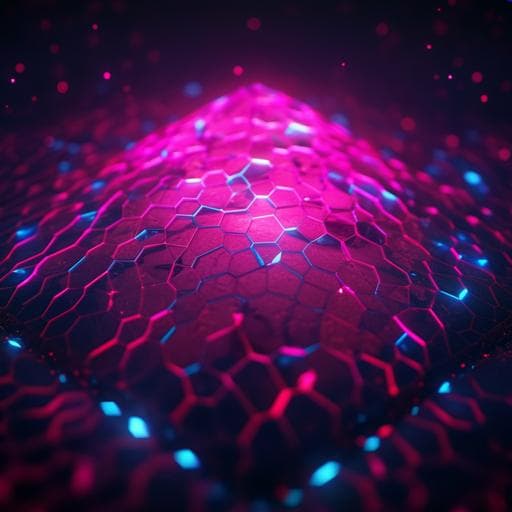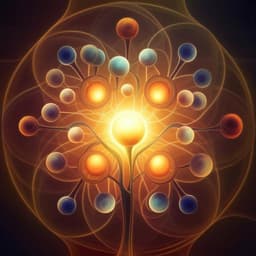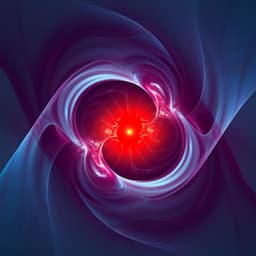
Physics
Improving the creation of SiV centers in diamond via sub-µs pulsed annealing treatment
Y. Tzeng, F. Ke, et al.
This groundbreaking study showcases a sub-µs pulsed annealing treatment that dramatically enhances the photoluminescence of silicon-vacancy centers in diamond, conducted by a team of experts including Yan-Kai Tzeng and Steven Chu. With a remarkable 2.5-fold increase in emitting centers, this research opens new avenues for efficient SiV center creation.
~3 min • Beginner • English
Introduction
Color centers in diamond are key platforms for quantum technologies. Nitrogen-vacancy (NV) and silicon-vacancy (SiV) centers are the best studied; NV centers offer room-temperature spin coherence but have low zero-phonon line (ZPL) emission (~4%) and strong inhomogeneous broadening due to an electric dipole. SiV centers possess inversion symmetry, no permanent dipole, a narrow ZPL at 738 nm with a large Debye–Waller factor (~70%), and fast photon emission, making them attractive as single-photon sources for integrated photonics. Conventional fabrication routes—ion implantation and chemical vapor deposition (CVD)—have limitations: ion implantation induces significant lattice damage and exhibits low conversion efficiency of implanted Si into SiV relative to NV, while CVD’s plasma environment complicates precise growth control. High-pressure high-temperature (HPHT) methods in a laser-heated diamond anvil cell (DAC) offer in situ control of temperature and pressure and enable mechanistic studies. The research question addressed here is how to create and stabilize optically active SiV centers more efficiently by controlling annealing temporally to promote formation while suppressing defect migration and loss to surfaces. The study introduces sub-microsecond pulsed annealing to enhance SiV photoluminescence and elucidates the thermodynamic and kinetic conditions for SiV formation from a silicon-containing adamantane precursor.
Literature Review
Prior work established NV and SiV centers as prominent diamond color centers with distinct optical properties. Ion implantation of Si followed by high-temperature annealing can introduce SiV but with low conversion efficiency and high lattice damage; adding vacancies via electron irradiation boosts conversion yet further damages the lattice. CVD enables doped diamond growth but suffers from difficult control of high-temperature plasma conditions and lacks in situ insight into defect formation and migration. HPHT synthesis in DACs has been used to form nanodiamonds and incorporate SiV using tetraethylorthosilicate precursors. Adamantane precursors, including nitrogen-functionalized variants, have proven effective for laser-induced diamond synthesis at high pressure and moderate temperature, motivating the use of silane-functionalized adamantane (AdaSi) for SiV. However, real-time mapping of formation temperature/pressure, formation energy thresholds, and the impact of annealing timescales on defect migration had not been systematically explored before this work.
Methodology
- Precursor and sample stack: A silane-functionalized adamantane precursor (adamantylethyltrichlorosilane, AdaSi; 95% purity) was loaded atop a 100-nm-thick tungsten (W) film deposited by DC-magnetron sputtering on exfoliated fluorine mica (150 × 150 × 1 µm). The W served as an optical absorber for 1064 nm heating. A sandwiched geometry (AdaSi/mica/W/AdaSi) ensured homogeneous coupling and reproducible power–temperature behavior.
- High-pressure platform: A Mao–Bell-type symmetric DAC with 500 µm culets generated pressure. A 301 stainless steel gasket was indented to 40 µm thickness and a 295 µm hole formed the sample chamber. Pressure was calibrated via ruby R-line fluorescence (694.25 nm) and the diamond Raman shift near 1332 cm⁻¹ (with stress-induced blue shift).
- Laser heating and temporal control: A 1064 nm Nd:YLF continuous-wave laser was modulated by an acousto-optic modulator (AOM; 110 MHz, ~150 ns rise/fall time) to deliver controlled pulses. Heating beam was focused onto the W film using a long-working-distance objective (NA 0.4). Achieved heating and cooling rates were ~0.1 GK/s and ~0.1 MK/s, respectively. Beam spots used included ~2.5 µm (FWHM) for synthesis and ~21.5 µm (FWHM) for annealing areas encompassing multiple crystallites.
- Ultrafast thermometry: Instead of full-spectrum pyrometry, two near-IR windows (900–1450 nm; 1550–2200 nm) were detected simultaneously. The intensity ratio (B/A) was calibrated using filament lamps and a blackbody pyrometer to extract temperature with ~1 µs temporal resolution and ±50 K accuracy above ~1000 K (limited sensitivity below 1000 K for the 900–1450 nm detector). Temperature transients during ms and µs pulses were recorded, revealing oscillations attributed to melting/resolidification dynamics in the W thin film and possible AdaSi melting at HPHT.
- SiV formation mapping: At multiple pressures (≈18–20 GPa), time-resolved PL (excitation 514.5 nm) was recorded to detect SiV ZPL emergence and to identify induction times and energy fluence thresholds for SiV formation. A pressure–temperature synthesis diagram was constructed.
- Annealing protocols: After SiV-containing diamond formation from a 2.5 µm heated spot at ~18 GPa, larger-area CW or pulsed annealing was applied using a 21.5 µm beam at a reduced intensity (260 kW/cm²) to avoid W melting. Pulsed annealing used AOM-set repetition rates of 10, 100, 1k, 10k, and 50k Hz with corresponding pulse widths of 1 ms, 100 µs, 10 µs, 1 µs, and 200 ns, respectively, all at the same average intensity. SiV photoluminescence (PL) ratios Ifinal/Iinitial were tracked versus annealing time.
- Characterization: In situ PL under pressure quantified SiV ZPL behavior (including pressure-induced blue shift). Ex situ after pressure release, scanning electron microscopy (SEM), Raman spectroscopy (532 nm excitation), and energy-dispersive X-ray spectroscopy were used to assess diamond quality; absence of PL peaks from other known vacancy complexes suggested low concentrations below detection. ZPL narrowing with pulsed annealing was monitored.
- Simulations: Density functional theory (VASP) with nudged elastic band (NEB) calculations on a 2×2×2 diamond supercell (64 C atoms) evaluated minimum energy paths and diffusion barriers for SiV⁻ and neutral vacancies V⁰. Multiple irreducible pathways were enumerated; NEB with up to nine images identified lowest barriers. Diffusivities were estimated using transition-state theory D = ν0 d² exp(−ΔE/kBT).
Key Findings
- Ultrafast thermometry: Achieved 1 µs resolution, ±50 K absolute accuracy above ~1000 K using two-window radiometry; observed temperature oscillations during heating due to W thin-film melting/resolidification dynamics.
- Formation conditions: Constructed a pressure–temperature synthesis diagram for SiV-containing diamond. At ~20 GPa, the minimum temperature to form SiV from AdaSi was ~1200 K.
- Energy/fluence thresholds: Estimated threshold energy fluence for SiV formation of ~0.18 kJ/cm² (18–20 GPa). Examples:
• 18.4 GPa, 33 MW/cm², 2.5 µm spot: 5 µs induction (≈0.165 kJ/cm²).
• 19.5 GPa, 0.5 MW/cm², 21.5 µm spot: 200 µs delivery (≈0.100 kJ/cm²).
• 18.4 GPa, nanosecond pulsed (~5 µm spot, 25 µJ, 5 ns): ≈0.176 kJ/cm².
- Annealing outcome (PL evolution):
• CW annealing at 260 kW/cm² caused rapid PL decay; half-maximum decay time ~180 s and near-zero SiV PL after extended treatment.
• Pulsed annealing effectiveness depends strongly on pulse width:
- 50 kHz, 200 ns pulses: sustained PL enhancement to ~250% of initial, with no visible decay over ≥10 h.
- 1 µs pulses: PL increased to ~200% without decay over ≥10 h.
- 10–100 µs pulses: initial PL increase (~150%) followed by decrease to ~50% (10 µs) or near-zero (100 µs) over tens of minutes to hours.
- 10 Hz, 1 ms pulses: not beneficial; longer timescales facilitate migration losses.
• ZPL narrowing accompanied pulsed annealing, indicating improved crystal quality.
- Diffusion kinetics (theory): NEB barriers: SiV diffusion barrier ~12.3 eV; vacancy diffusion barrier ~2.7 eV. Calculated diffusivities show vacancies diffuse orders of magnitude faster than SiV from 800–1600 K, implying higher-temperature annealing preferentially removes free vacancies to surfaces while SiV centers remain stabilized.
- Mechanistic insight: Sub-µs pulses enable activation for SiV formation while limiting the time available for SiV migration to surfaces or grain boundaries, thereby boosting the number of optically active centers and preserving them.
Discussion
The study directly addresses how temporal control of annealing influences the formation and stability of SiV centers. Mapping the formation threshold and temperature under HPHT, combined with sub-µs pulsed annealing, demonstrates that very short thermal activation windows favor SiV formation and suppress diffusion-driven loss. Experimental PL trends show that CW or long-pulse anneals allow significant migration and quenching, whereas 1 µs and 200 ns pulses increase and sustain SiV PL for hours. Theoretical diffusion barriers and diffusivity calculations rationalize these observations: vacancies (low barrier) are highly mobile and can be depleted to surfaces during brief pulses, while SiV centers (high barrier) remain largely immobile, thus stabilized. The narrowing of the SiV ZPL indicates concurrent improvement of diamond crystalline quality during pulsed annealing. These findings are significant for quantum photonics, where emission brightness and spectral stability are critical, and they offer a practical pathway to increase emitter yield and stability. The approach is expected to generalize to other group IV/V impurity–vacancy centers and beyond diamond to materials where rapid thermal processing can improve optoelectronic properties.
Conclusion
Using an AOM-modulated laser-heated DAC, the work establishes precise in situ thermometry and P–T mapping for SiV formation from a silane-functionalized adamantane precursor, identifying a formation temperature of ~1200 K at 20 GPa and an energy fluence threshold near 0.18 kJ/cm². Sub-µs pulsed annealing is shown to markedly improve SiV photoluminescence—up to 250% using 200 ns pulses at 50 kHz—with stability over at least 10 hours, while CW or longer-pulse annealing reduces PL via defect migration. NEB/DFT calculations explain the kinetic selectivity: vacancies diffuse much faster (2.7 eV barrier) than SiV centers (12.3 eV), enabling vacancy removal while preserving SiV. This pulsed annealing strategy provides a mechanistic framework and a practical route to enhance the creation and stabilization of SiV centers and is likely applicable to other impurity–vacancy systems in diamond. More broadly, iterative rapid pulsed-laser annealing with optimized time–temperature profiles could improve luminescent and electronic properties in diverse materials, including perovskite solar cells and transition metal dichalcogenide transistors. Future work could explore pressure dependence of diffusivities, optimize pulse sequences, and extend to other dopants and host materials.
Limitations
- Thermometry sensitivity limits: Below ~1000 K the 900–1450 nm detector lacks sensitivity, restricting absolute temperature accuracy to higher-temperature regimes; absolute accuracy is ±50 K.
- Thin-film heating dynamics: Temperature oscillations linked to W thin-film melting/resolidification and migration complicate thermal profiles for certain pulse widths, potentially affecting reproducibility at intermediate timescales.
- Pressure conditions in theory: NEB and diffusivity calculations were performed at ambient pressure; while trends are expected to hold at high pressure due to diamond’s small compressibility, this remains an assumption not explicitly verified computationally under pressure.
- Ex situ materials characterization: Detailed structural assessments (SEM, Raman, EDS) were conducted after pressure release; in situ structural probes during HPHT were limited, and non-detection of other defect centers is constrained by instrumental sensitivity.
- Annealing parameter space: Pulsed annealing explored discrete frequencies/pulse widths at a single average intensity (260 kW/cm²); broader parameter sweeps (e.g., varying duty cycle, peak power, temperature setpoints) could further optimize outcomes.
Related Publications
Explore these studies to deepen your understanding of the subject.







